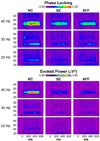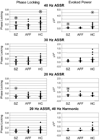Gamma-band auditory steady-state responses are impaired in first episode psychosis
- PMID: 18400208
- PMCID: PMC2579257
- DOI: 10.1016/j.biopsych.2008.02.021
Gamma-band auditory steady-state responses are impaired in first episode psychosis
Abstract
Background: In chronic schizophrenia and chronic bipolar disorder, gamma band (30-100 Hz) auditory steady-state electroencephalogram responses (ASSRs) are reduced in power and phase locking, likely reflecting neural circuit dysfunction. Here we examined whether gamma ASSR deficits are also present at first hospitalization for psychosis.
Methods: Subjects were 16 first episode schizophrenia patients (SZ), 16 first episode affective disorder patients (AFF) (13 with bipolar disorder), and 33 healthy control subjects (HC). Stimuli were 20-, 30-, and 40-Hz binaural click trains. The ASSR phase locking and evoked power were analyzed with the Morlet wavelet transform.
Results: At 40-Hz stimulation, SZ and AFF had significantly reduced phase locking compared with HC. This deficit was more pronounced over the left hemisphere in SZ. Evoked power at 40 Hz was also reduced in the patients compared with HC. At 30-Hz stimulation phase locking and evoked power were reduced in both patient groups. The 20-Hz ASSR did not differ between groups, but phase locking and evoked power of the 40-Hz harmonic of the 20-Hz ASSR were reduced in both SZ and AFF. Phase locking of this 40-Hz harmonic was correlated with total positive symptoms in SZ.
Conclusions: The gamma ASSR deficit is present at first hospitalization for both schizophrenia and affective disorder but shows a left hemisphere bias in first hospitalized SZ. Some of the neural circuitry abnormalities underlying the gamma ASSR deficit might be common to psychoses in general, whereas others might be specific to particular disorders.
Figures




References
-
- Singer W. Neuronal synchrony: a versatile code for the definition of relations? Neuron. 1999;24:49–65. - PubMed
-
- Lewis DA, Hashimoto T, Volk DW. Cortical inhibitory neurons and schizophrenia. Nat Rev Neurosci. 2005;6:312–324. - PubMed
-
- Uhlhaas PJ, Singer W. Neural synchrony in brain disorders: relevance for cognitive dysfunctions and pathophysiology. Neuron. 2006;52:155–168. - PubMed
Publication types
MeSH terms
Grants and funding
LinkOut - more resources
Full Text Sources
Other Literature Sources
Medical

